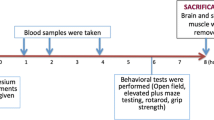Summary
Guanethidine was intravenously injected into rats and was subsequently determined in the hearts by extracting the tissue with trichloroacetic acid, purifying the extracts on cation exchange columns and by paper chromatography, and coupling the guanethidine with ninhydrin in alkaline solution before fluorimetric estimation. The concentration in the heart reached a maximum of 9 μg/g within 15 min of injecting 15 mg/kg, and was still 6.2 and 5.7 μg/g after 1 and 3 hours, respectively.
Guanethidine caused a decrease of the heart noradrenaline concentration, measured fluorimetrically, by 56% in 3 hours and by 93% in 14 hours. The adrenaline concentration was likewise decreased.
A metabolite with the guanidium group still intact was contained in the eluates of the ion exchange columns, but was separated from guanethidine by paper chromatography. The metabolite was detectable in heart extracts as soon as 6 min after injection of the drug, and the ratio of metabolite to guanethidine was then identical in heart and blood. The proportion in the heart rose steadily with time after injection, being about 50% after 3 hours. By this time 10–15% of the guanethidine administered had been excreted unchanged in the urine in addition to the metabolite mentioned.
The results indicate that guanethidine is rapidly concentrated and firmly held in the heart throughout the period of noradrenaline depletion.
Similar content being viewed by others
Literatur
Bertler, A., A. Carlsson andE. Rosengren: A method for the fluorimetric determination of adrenaline and noradrenaline in tissues. Acta physiol. scand.44, 273 (1958).
Boura, A. L. A., F. C. Copp, W. G. Duncombe, A. F. Green andA. McCoubrey: The selective accumulation of bretylium in sympathetic ganglia and their post-ganglionic nerves. Brit. J. Pharmacol.15, 265 (1960).
Brodie, B. B.: Storage and release of 5-hydroxytryptamine. 5-Hydroxytryptamine, p. 64. Ed. byG. P. Lewis. London: Pergamon Press 1958.
Burn, J. H.: A new view of adrenergic nerve fibres, explaining the action of reserpine, bretylium, and guanethidine. Brit. med. J.1961 I, 1623.
Cass, R., R. Kuntzman andB. B. Brodie: Norepinephrine depletion as a possible mechanism of action of guanethidine, a new hypotensive agent. Proc. Soc. exp. Biol. (N. Y.)103, 871 (1960).
——, andT. L. Spriggs: Tissue amine levels and sympathetic blockade after guanethidine and bretylium. Brit. J. Pharmacol.17, 442 (1961).
Conn, R. B.: Fluorimetric determination of creatine. Clin. Chem.6, 537 (1960).
——, andR. B. Davis: Green fluorescence of guanidium compounds with ninhydrin. Nature (Lond.)183, 1053 (1959).
Crout, J. R., C. R. Creveling andS. Udenfriend: Norepinephrine metabolism in rat brain and heart. J. Pharmacol. exp. Ther.132, 269 (1961).
Dollery, C. T., D. Emslie-Smith andM. D. Milne: Clinical and pharmacological studies with guanethidine in the treatment of hypertension. Lancet1960 II, 381.
Hess, S. M., P. A. Shore andB. B. Brodie: Persistence of reserpine action after the disappearance of drug from brain: Effect on serotonin. J. Pharmacol. exp. Ther.118, 84 (1956).
Huković, S., u.E. Muscholl: Die Noradrenalin-Abgabe aus dem isolierten Kaninchenherzen bei sympathischer Nervenreizung und ihre pharmakologische Beeinflussung. Naunyn-Schmiedeberg's Arch. exp. Path. Pharmak.244, 81 (1962).
McCubbin, J. W., Y. Kaneko andI. H. Page: The peripheral cardiovascular actions of guanethidine in dogs. J. Pharmacol. exp. Ther.131, 346 (1961).
Sanan, S., andM. Vogt: Effect of drugs on the noradrenaline content of brain and peripheral tissues and its significance. Brit. J. Pharmacol.18, 109 (1962).
Tompsett, S. L.: The separation of alkaloids and related substances from urinethe use of cation exchange resins. Acta pharmacol. (Kbh.)17, 295 (1960).
——W. Forshall andD. C. Smith: The identification and determination of some hypotensive drugs in urine. Acta pharmacol. (Kbh.)18, 75 (1961).
Author information
Authors and Affiliations
Additional information
Mit 2 Textabbildungen
Rights and permissions
About this article
Cite this article
Bisson, G.M., Muscholl, E. Die Beziehung zwischen der Guanethidin-Konzentration im Rattenherzen und dem Noradrenalingehalt. Naunyn - Schmiedebergs Arch 244, 185–194 (1962). https://doi.org/10.1007/BF00738224
Received:
Issue Date:
DOI: https://doi.org/10.1007/BF00738224




